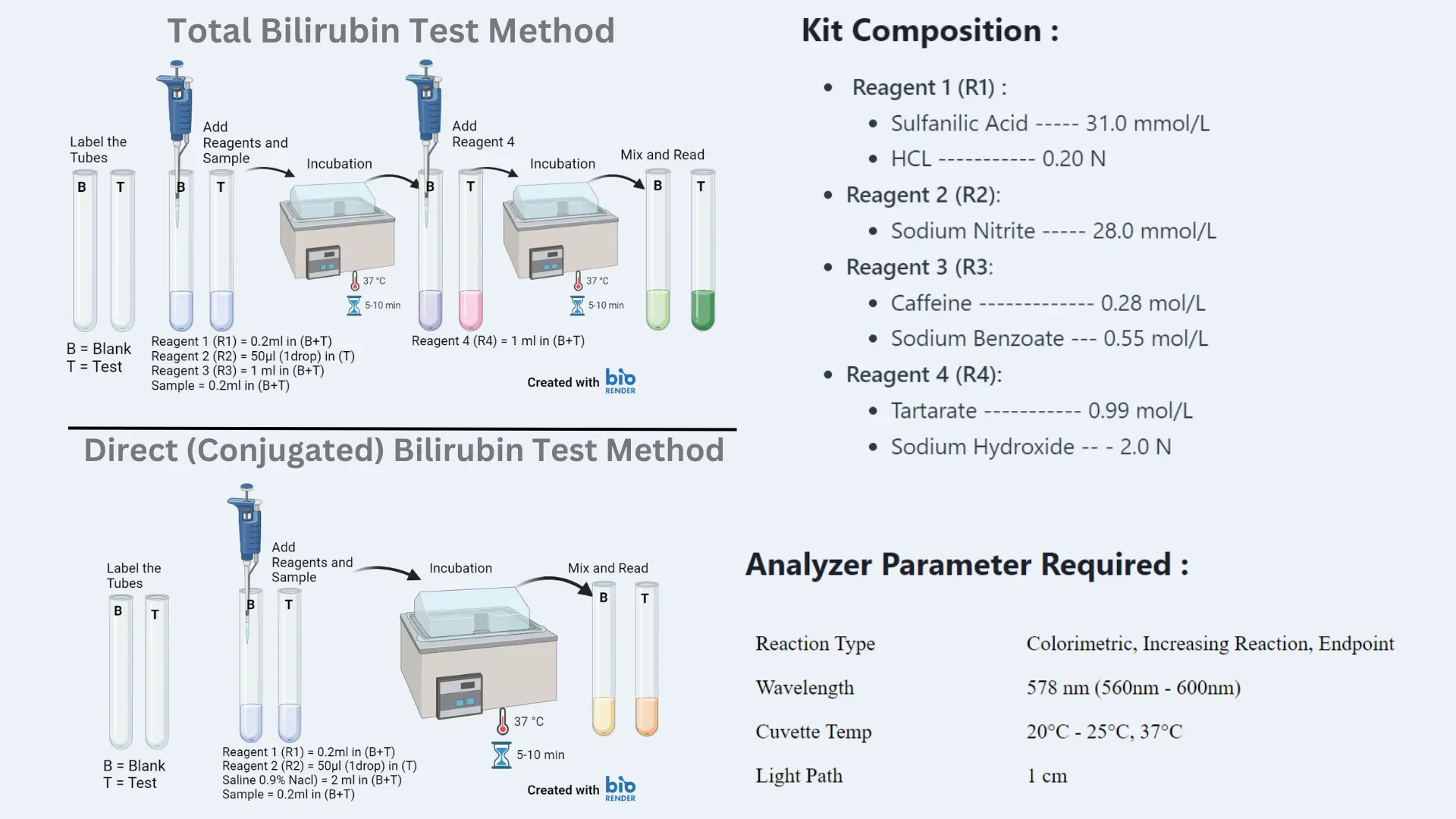
A small amount of your blood is needed to perform this test. The blood sample is obtained through venipuncture: A needle is inserted into a vein through the skin in your arm or hand, and a small amount of blood is collected in a test tube.

Also Known As: Total Bilirubin, TBIL, Neonatal Bilirubin, Direct Bilirubin, Conjugated Bilirubin, Indirect Bilirubin, Unconjugated Bilirubin, TB
Test Panel: Total Bilirubin, Conjagated Bilirubin, Unconjugated Bilirubin, ALT, AST, ALP, Total Protein, Albumin, Globulin, A/G ratio, GGT,
Jendrassik Grof method
Colorimetric, Increasing Reaction, Endpoint
Principle :
Bilirubin is formed from the heme portion of hemoglobin released by aged or damaged red blood cells. It is then converted in the liver to bilirubin monoglucuronide and bilirubin diglucuronide. Free bilirubin is not soluble in aqueous solution and requires solubilization by alcohols or other solvents to react. Reactions carried out in these solvents provide measurements of total bilirubin. Mono and diglucuronides of bilirubin are water soluble and measurements performed in aqueous solution measure what in this form is called direct bilirubin. In our reagents we use dimethylsulfoxide (DMSO) and ethylene glycol as solvents for the total bilirubin assay. Bilirubin in these solvents readily reacts with diazotized sulfanilic acid to produce an intensely colored diazo dye. The intensity of color of this dye in solution is proportional to the concentration of direct or total bilirubin, resp.
Kit Composition :
- Reagent 1 (R1) :
- Sulfanilic Acid —– 31.0 mmol/L
- HCL ———– 0.20 N
- Reagent 2 (R2):
- Sodium Nitrite —– 28.0 mmol/L
- Reagent 3 (R3:
- Caffeine ————- 0.28 mol/L
- Sodium Benzoate — 0.55 mol/L
- Reagent 4 (R4):
- Tartarate ———– 0.99 mol/L
- Sodium Hydroxide — – 2.0 N
Note : Reagent 4 Conatins Caustic Material.
Test Requirements :
- Test Tubes
- Micropipettes
- Tips
- Bio-Chemistry analyzer
- Bilirubin (Total & Direct) Test Kit
- Calibrator
Reagent Preparation and Stability :
All Reagent are Ready to use.
Avoid direct exposure to light. All reagents are stable upto expiry date at room temperature.
Specimen collection and handling:
Analyzer Parameter Required :
| Reaction Type | Colorimetric, Increasing Reaction, Endpoint |
| Wavelength | 578 nm (560nm – 600nm) |
| Cuvette Temp | 20°C – 25°C, 37°C |
| Light Path | 1 cm |
Test Procedure:
Pipette into clean dry test tube labeled as Test (T) and Blank Label (B) and or as your required:
Total Bilirubin :

| Specimin | (T) | (B) |
|---|---|---|
| Reagent 1 (R1) | 0.2 ml (200 µl) | 0.2 ml (200 µl) |
| Reagent 2 (R2) | 1 Drop (0.05 ml 0r 50 µl)) | – |
| Reagent 3 (R3) | 1.0 ml (1000 µl) | 1.0 ml (1000 µl) |
| Sample | 0.2 ml (200 µl) | 0.2 ml (200 µl) |
Mix and Incubate for 10 mints at 20°C to 25°C. Then add
| Reagent 4 (R4) | 1.0 ml (1000 µl) | 1.0 ml (1000 µl) |
Mix and Incubate 5 min at 20°C to 25°C. Measure absorbance of sample against sample blank. The color intensity is stable for 30 mints.
Direct Bilirubin:

| Specimin | (T) | (B) |
|---|---|---|
| Reagent 1 (R1) | 0.2 ml | 0.2 ml |
| Reagent 2 (R2) | 1 Drop (0.05 ml) | – |
| Saline 0.9% Nacl | 2.0 ml | 2.0 ml |
| Sample | 0.2 ml | 0.2 ml |
Mix and Incubate exactly 5 min at 20°C to 25°C. Measure absorbance of sample against sample blank. The color intensity is stable for 30 mints.
Calculation:
If you have No Analyzer then you can Measure absorbane on calorimeter and then calculate manually.
- Total Bilirubin: Abs (T) x 10.8
- Direct (Conjugated) Bilirubin: Abs (T) x 14.4
Indirect (UnConjugated) Bilirubin:
Indirect (Unconjugated) Bilirubin will not be measured, this will calculate.
Total Bilirubin–Direct Bilirubin= Indirect (UnConjugated) Bilirubin
LINEARITY :
Total Bilirubin : 30.0 mg/dl
Direct (Conjugated) Bilirubin: 10.0 mg/dl
if the activity exceeds this limit dilute the sample with normal saline (NaCl 0.9 %) and multiply result by dilution factor.
QUALITY CONTROL :
For accuracy it is necessary to run known controls with every assay.
Normal Value :
| Total Bilirubin | 0.2 – 1.0 mg/dL |
| Direct (Conjugated) Bilirubin | 0.0 – 0.2 mg/dL |
| Indirect (Unconjugated) Bilirubin | 0.2 – 0.8 mg/dL |
⚠️ Disclaimer:
The content on LabTestsGuide.com is for informational and educational purposes only. We do not guarantee the accuracy, completeness, or timeliness of the information provided. Always consult qualified healthcare professionals for medical advice, diagnosis, or treatment. LabTestsGuide.com is not liable for any decisions made based on the information on this site.




